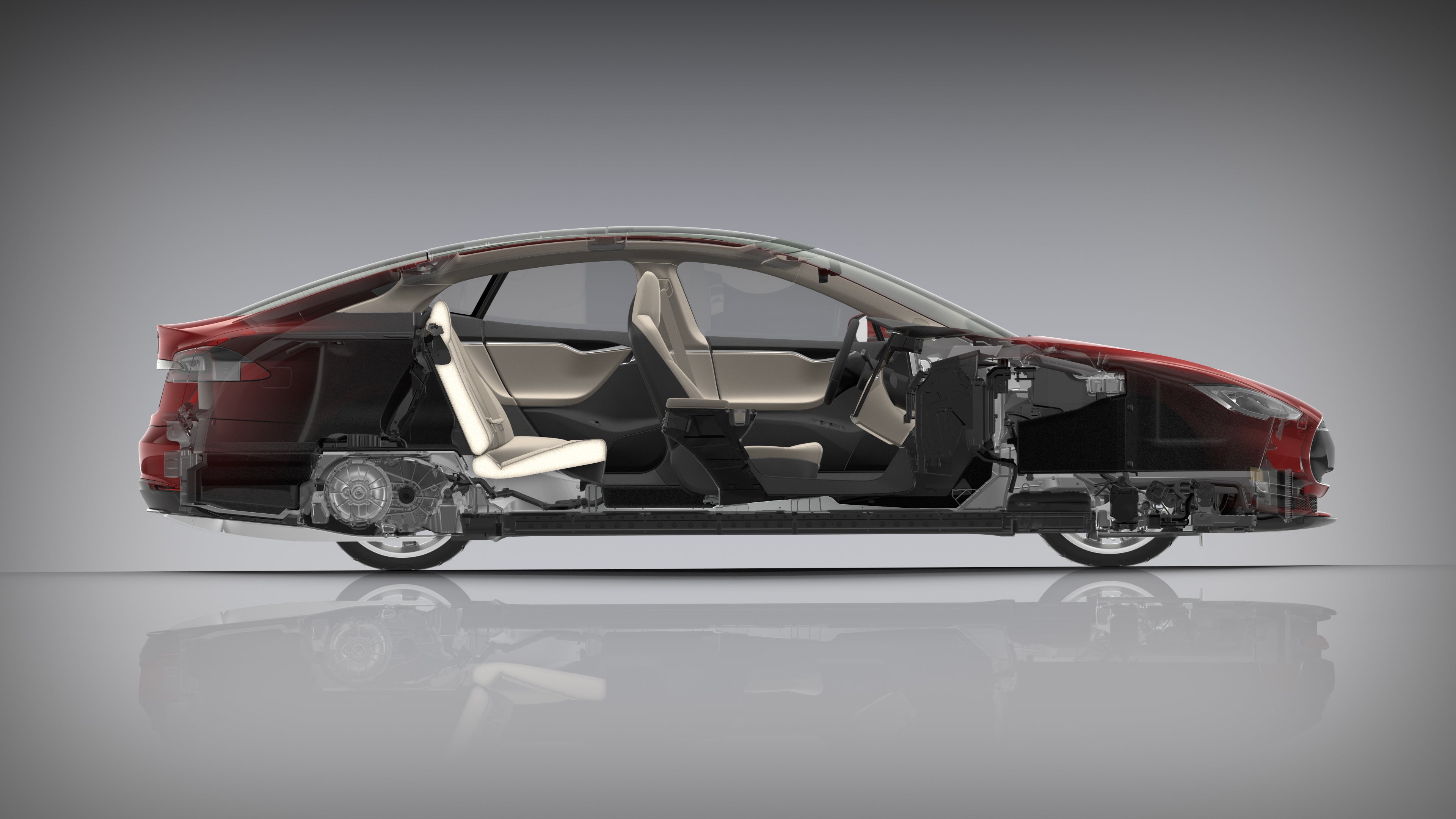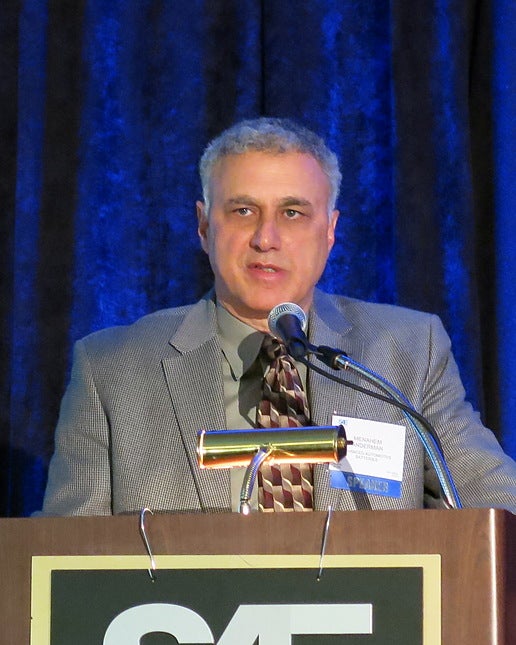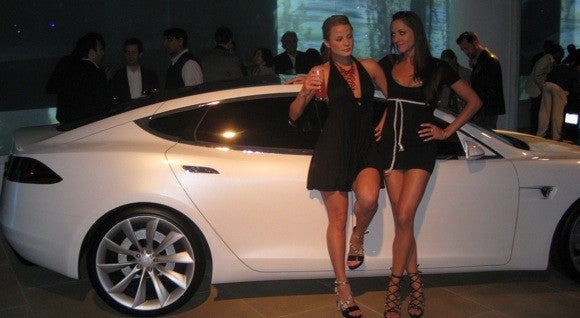 "webmonkees" (kayoteq-of-the-forest)
"webmonkees" (kayoteq-of-the-forest)
02/19/2014 at 21:58 • Filed to: Tesla
 0
0
 25
25
 "webmonkees" (kayoteq-of-the-forest)
"webmonkees" (kayoteq-of-the-forest)
02/19/2014 at 21:58 • Filed to: Tesla |  0 0
|  25 25 |

We all knew it. Prismatic cell configurations. Of course.

Now that's a cool job description.
From SAE Geek News:
"Despite Tesla Motors' proven success with 18650-type Li-ion cells in its Model S, the industry's best-known EV battery analyst isn't betting that other automakers will adopt that form factor, which describes the cylindrical battery case's 18 x 65 mm dimensions.
Dr. Menahem Anderman, President of consultants Advanced Automotive Batteries, also is not convinced that Tesla engineers will continue to architect future battery packs and EV powertrains around the small, reliable, and thermodynamically efficient 18650, billions of which are produced annually (in various iterations) for the consumer electronics industry. Tesla is the only automotive OEM to use the 18650 cell.
"I don't see other OEMs going to the 18650," Dr. Anderman stated following a presentation on future battery trends at the 2014 SAE Hybrid & EV Symposium in La Jolla, CA, on February 13. He said the cost advantage Tesla realized when it first specified the 18650 cells for its original 2008 Roadster model has "eroded" compared with newly developed cylindrical, pouch, and prismatic cell configurations used across the auto industry, despite Tesla's increasing production volumes."
Sorry about that. Here.

 signintokinjalol
> webmonkees
signintokinjalol
> webmonkees
02/19/2014 at 22:10 |
|
This is the important thing everyone has to know...batteries erode.
A lot.
And each one does so differently depending on use and age.
 Manuél Ferrari
> signintokinjalol
Manuél Ferrari
> signintokinjalol
02/19/2014 at 23:34 |
|
That's the thing I can't understand - did Tesla figure out a way to slow down erosion significantly enough to prevent the cars from becoming bricks in 5-10 years? Or they haven't and just don't care?
Every electronic device I've ever had that uses a Li-ion battery has suffered from serious capacity erosion. Every time we deplete and charge our devices the battery's full charge lasts a little bit less time. After a year or two the difference is significant. Eventually the battery has to be replaced and if it's built in to the device (e.g. iPhone) you're screwed.
I would never spend a bunch of money on a Tesla until someone could explain to me how the car's range will be at least 90% of what it was on day 1 after 10 years of ownership.
 bhardoin
> Manuél Ferrari
bhardoin
> Manuél Ferrari
02/20/2014 at 00:58 |
|
My understanding was that the system intelligently regulates the charge of cells individually to maximize their life.
In other words, you can completely discharge and recharge your phone/laptop daily for about 2 years. But Tesla assumes that you won't need to fully use your 200 mile range daily, and can therefore use certain cells to maximize the life of the battery as a whole. Supposedly about 10 years, if I remember right. And after 10 years in any other car, you'd be lucky not to have some equally heavy engine or transmission work due.
 Manuél Ferrari
> bhardoin
Manuél Ferrari
> bhardoin
02/20/2014 at 01:17 |
|
Interesting. So by managing which cells are recharged and when they are able to get the cells to last much longer?
I knew they had a lot of tech behind how it works but never saw a brief explanation of it like you just provided. I never really did research on it either, just saw some stuff here and there.
I wonder what the cost would be to replace all battery cells (if needed) in 10 years. That cost could be compared to the cost the expected work that would need to be done to a comparably priced luxury car after 10 years.
 Yowen - not necessarily not spaghetti and meatballs
> webmonkees
Yowen - not necessarily not spaghetti and meatballs
> webmonkees
02/20/2014 at 08:26 |
|

She has her damn heels on the paint job!!!!
 Yowen - not necessarily not spaghetti and meatballs
> Yowen - not necessarily not spaghetti and meatballs
Yowen - not necessarily not spaghetti and meatballs
> Yowen - not necessarily not spaghetti and meatballs
02/20/2014 at 08:27 |
|
I am however a huge fan of the shoes to the right, I love those string up shoes for some reason.
 MontegoMan562 is a Capri RS Owner
> Manuél Ferrari
MontegoMan562 is a Capri RS Owner
> Manuél Ferrari
02/20/2014 at 12:42 |
|
after reading your brief convo here, i wonder if people will take advantage of those battery swap stations he was demonstrating a while ago?
Pull in to take a new batter when yours isn't doing so great anymore and never go back!
 Manuél Ferrari
> MontegoMan562 is a Capri RS Owner
Manuél Ferrari
> MontegoMan562 is a Capri RS Owner
02/20/2014 at 15:32 |
|
Great point. I have been wondering about the same topic, and of the viability of the battery swapping idea.
If Tesla's batteries end up lasting less years than they estimated than the whole battery swapping option could become unworkable - both because owners could be swapping batteries that produce short ranges into the pool and because owners could swap bad batteries into their car.
Imagine if you did a battery swap and then your car ran out of charge before it was supposed to and it died on the highway. If it was considered bricked would you be able to get new batteries by blaming it on the place you got the swap?
 bhardoin
> Manuél Ferrari
bhardoin
> Manuél Ferrari
02/20/2014 at 23:57 |
|
Yup. At least, that's my understanding. I'm sure there's a bunch of other wizardry there, but I think that's a large part of it.
I'm curious where battery technology will be in 10 years. By the time you have to buy a new battery, you may be able to double your range as well. Or by then they'll just be way cheaper.
 bhardoin
> MontegoMan562 is a Capri RS Owner
bhardoin
> MontegoMan562 is a Capri RS Owner
02/20/2014 at 23:58 |
|
Haha. I remember hearing some policy they had about that, to keep people from doing what you just described. But I don't remember how it worked. Time to research...
 bhardoin
> MontegoMan562 is a Capri RS Owner
bhardoin
> MontegoMan562 is a Capri RS Owner
02/21/2014 at 00:04 |
|
http://green.autoblog.com/2013/06/21/tes…
Third paragraph. "Later, you can get your old pack back (again, fully charged and for another $60 fee) or you can pay an undetermined fee and keep the pack. Forbes says there will be a warranty available on the replacement pack, depending on its condition."
 Manuél Ferrari
> bhardoin
Manuél Ferrari
> bhardoin
02/21/2014 at 00:09 |
|
I try reading up on battery innovations now and then. It seems like scientists are able to generate lighter batteries with more capacity in the lab. But like anything else the problem is commercial viability. Science has not found a way to make much better batteries at costs that will work.
The interesting thing about Tesla is that they have economies of scale that other companies don't have. That will help when it comes to using new tech at a price that is viable.
Batteries are definitely the weak link. Electronic motors work just fine. We need better batteries that last longer and are cheaper to replace.
 bhardoin
> Manuél Ferrari
bhardoin
> Manuél Ferrari
02/21/2014 at 00:16 |
|
Well, the innovations you hear about are constantly about 10 years ahead of the products. But batteries are improving - just not with Moore's law, so they look slow relatively. Batteries now have way better power density and charge times than they did 5 years ago. And all those things were the advances in lithium ion batteries you heard about in the early 00's.
 Manuél Ferrari
> bhardoin
Manuél Ferrari
> bhardoin
02/21/2014 at 00:18 |
|
If only they evolved like computer processors did! That would be great
 bhardoin
> Manuél Ferrari
bhardoin
> Manuél Ferrari
02/21/2014 at 00:20 |
|
I'd be more powerful than Thor if batteries doubled in power density every 18 months since the 60s.
 Manuél Ferrari
> bhardoin
Manuél Ferrari
> bhardoin
02/21/2014 at 00:24 |
|
This is kind of cool:
http://news.discovery.com/tech/alternati…
 bhardoin
> Manuél Ferrari
bhardoin
> Manuél Ferrari
02/21/2014 at 00:36 |
|
Very cool. But I can't imagine having that kind of power right next to a processor without creating some unreasonable electromagnetic noise.
 Manuél Ferrari
> bhardoin
Manuél Ferrari
> bhardoin
02/21/2014 at 01:40 |
|
It might be a pipe dream. But would be cool if it works!
 MontegoMan562 is a Capri RS Owner
> bhardoin
MontegoMan562 is a Capri RS Owner
> bhardoin
02/21/2014 at 09:18 |
|
Interesting. Thanks for doing the googling for me lol
 MontegoMan562 is a Capri RS Owner
> Manuél Ferrari
MontegoMan562 is a Capri RS Owner
> Manuél Ferrari
02/21/2014 at 09:20 |
|
I think we just found an odd chink in the Tesla Battery armor....
 Manuél Ferrari
> MontegoMan562 is a Capri RS Owner
Manuél Ferrari
> MontegoMan562 is a Capri RS Owner
02/21/2014 at 13:56 |
|
It's a very odd situation. The batteries are very expensive. Having them swapped out seems so problematic to me.
If the batteries cost as much as a propane tank did then it would be no big deal if your car bricked after a swap. It would be annoying but not create a potential lawsuit...
 MontegoMan562 is a Capri RS Owner
> Manuél Ferrari
MontegoMan562 is a Capri RS Owner
> Manuél Ferrari
02/21/2014 at 13:59 |
|
I actaully remember the common perception about the prius when it first came out was that they would be useless POS's in 7-8 years and you'd never be able to sell one used.
 Manuél Ferrari
> MontegoMan562 is a Capri RS Owner
Manuél Ferrari
> MontegoMan562 is a Capri RS Owner
02/21/2014 at 14:08 |
|
I remember that too. I believe the standard Prius has regular lead batteries and the plug-in version has Lio-ion?
 MontegoMan562 is a Capri RS Owner
> Manuél Ferrari
MontegoMan562 is a Capri RS Owner
> Manuél Ferrari
02/21/2014 at 14:37 |
|
I can't remember I try not to pay attention to them. But I DID make a Chevy Volt into an S Class car on Forza 4 recently LOL
 Manuél Ferrari
> MontegoMan562 is a Capri RS Owner
Manuél Ferrari
> MontegoMan562 is a Capri RS Owner
02/21/2014 at 14:45 |
|
Haha that is awesome.
I just looked it up. The first couple generations used nickel-metal hydride batteries. The Lio-ion started with the plug-in model.